Electro-Optical Modulation in High Q Metasurface Enhanced with Liquid Crystal Integration
Abstract
:1. Introduction
2. Design and Discussion
3. Optimization with Liquid Crystal
4. Conclusions
Author Contributions
Funding
Institutional Review Board Statement
Informed Consent Statement
Data Availability Statement
Conflicts of Interest
References
- Genevet, P.; Capasso, F.; Aieta, F.; Khorasaninejad, M.; Devlin, R. Recent advances in planar optics: From plasmonic to dielectric metasurfaces. Optica 2017, 4, 139–152. [Google Scholar] [CrossRef]
- Zheludev, N.I.; Kivshar, Y.S. From metamaterials to metadevices. Nat. Mater. 2012, 11, 917–924. [Google Scholar] [CrossRef] [PubMed]
- Bar-David, J.; Levy, U. Nonlinear diffraction in asymmetric dielectric metasurfaces. Nano Lett. 2019, 19, 1044–1051. [Google Scholar] [CrossRef] [PubMed]
- Chen, X.; Huang, L.; Mühlenbernd, H.; Li, G.; Bai, B.; Tan, Q.; Jin, G.; Qiu, C.-W.; Zhang, S.; Zentgraf, T. Dual-polarity plasmonic metalens for visible light. Nat. Commun. 2012, 3, 1198. [Google Scholar] [CrossRef] [PubMed]
- Dou, K.; Xie, X.; Pu, M.; Li, X.; Ma, X.; Wang, C.; Luo, X. Off-axis multi-wavelength dispersion controlling metalens for multi-color imaging. Opto Electron. Adv. 2020, 3, 19000. [Google Scholar] [CrossRef]
- Huang, Y.W.; Chen, W.T.; Tsai, W.Y.; Wu, P.C.; Wang, C.M.; Sun, G.; Tsai, D.P. Aluminum plasmonic multicolor meta-hologram. Nano Lett. 2015, 15, 3122–3127. [Google Scholar] [CrossRef]
- Smolyaninov, A.; El Amili, A.; Vallini, F.; Pappert, S.; Fainman, Y. Programmable plasmonic phase modulation of free-space wavefronts at gigahertz rates. Nat. Photonics 2019, 13, 431–435. [Google Scholar] [CrossRef]
- Schwarz, B. Mapping the world in 3D. Nat. Photonics 2010, 4, 429–430. [Google Scholar] [CrossRef]
- Indukuri, S.R.K.; Frydendahl, C.; Bar-David, J.; Mazurski, N.; Levy, U. WS2 monolayers coupled to hyperbolic metamaterial nanoantennas: Broad implications for light-matter-interaction applications. ACS Appl. Nano Mater. 2020, 3, 10226–10233. [Google Scholar] [CrossRef]
- Wang, Q.; Yuan, G.H.; Kiang, K.S.; Sun, K.; Gholipour, B.; Rogers, E.T.F.; Huang, K.; Ang, S.S.; Zheludev, N.I.; Teng, J.H. Reconfigurable phase-change photomask for grayscale photolithography. Appl. Phys. Lett. 2017, 110, 201110. [Google Scholar] [CrossRef] [Green Version]
- Rahmani, M.; Xu, L.; Miroshnichenko, A.E.; Komar, A.; Camacho-Morales, R.; Chen, H.; Zárate, Y.; Kruk, S.; Zhang, G.; Neshev, D.N.; et al. Reversible thermal tuning of all-dielectric metasurfaces. Adv. Funct. Mater. 2017, 27, 1700580. [Google Scholar] [CrossRef]
- Ou, J.Y.; Plum, E.; Jiang, L.; Zheludev, N.I. Reconfigurable photonic metamaterials. Nano Lett. 2011, 11, 2142–2144. [Google Scholar] [CrossRef] [PubMed]
- Shaltout, A.M.; Shalaev, V.M.; Brongersma, M.L. Spatiotemporal light control with active metasurfaces. Science 2019, 364, eaat3100. [Google Scholar] [CrossRef] [PubMed]
- Weigand, H.; Vogler-Neuling, V.V.; Escalé, M.R.; Pohl, D.; Richter, F.U.; Karvounis, A.; Timpu, F.; Grange, R. Enhanced electro-optic modulation in resonant metasurfaces of lithium niobate. ACS Photonics 2021, 8, 3004–3009. [Google Scholar] [CrossRef]
- Shirmanesh, G.K.; Sokhoyan, R.; Wu, P.C.; Atwater, H.A. Electro-optically tunable multifunctional metasurfaces. ACS Nano 2020, 14, 6912–6920. [Google Scholar] [CrossRef]
- Nemati, A.; Wang, Q.; Ang, N.S.S.; Wang, W.; Hong, M.; Teng, J. Ultra-high extinction-ratio light modulation by electrically tunable metasurface using dual epsilon-near-zero resonances. Opto Electron. Adv. 2021, 4, 20008. [Google Scholar] [CrossRef]
- Park, J.; Jeong, B.G.; Kim, S.I.; Lee, D.; Kim, J.; Shin, C.; Lee, C.B.; Otsuka, T.; Kyoung, J.; Kim, S.; et al. All-solid-state spatial light modulator with independent phase and amplitude control for three-dimensional LiDAR applications. Nat. Nanotechnol. 2021, 16, 69–76. [Google Scholar] [CrossRef]
- Li, S.-Q.; Xu, X.; Veetil, R.M.; Valuckas, V.; Paniagua-Domínguez, R.; Kuznetsov, A.I. Phase-only transmissive spatial light modulator based on tunable dielectric metasurface. Science 2019, 364, 1087–1090. [Google Scholar] [CrossRef]
- Holsteen, A.L.; Cihan, A.F.; Brongersma, M.L. Temporal color mixing and dynamic beam shaping with silicon metasurfaces. Science 2019, 365, 257–260. [Google Scholar] [CrossRef]
- Sautter, J.; Staude, I.; Decker, M.; Rusak, E.; Neshev, D.N.; Brener, I.; Kivshar, Y.S. Active tuning of all-dielectric metasurfaces. ACS Nano 2015, 9, 4308–4315. [Google Scholar] [CrossRef]
- Wang, C.; Zhang, M.; Chen, X.; Bertrand, M.; Shams-Ansari, A.; Chandrasekhar, S.; Winzer, P.; Lončar, M. Integrated lithium niobate electro-optic modulators operating at CMOS-compatible voltages. Nature 2018, 562, 101–104. [Google Scholar] [CrossRef]
- Gaborit, G.; Gaeremynck, Y.; Jarrige, P.; Lecoche, F.; Duvillaret, L. High dynamic range vectorial sensors for high power microwaves. IEEE Trans. Plasma Sci. 2013, 41, 285. [Google Scholar]
- Rybin, M.V.; Koshelev, K.L.; Sadrieva, Z.F.; Samusev, K.B.; Bogdanov, A.A.; Limonov, M.F.; Kivshar, Y.S. High-Q supercavity modes in subwavelength dielectric resonators. Phys. Rev. Lett. 2017, 119, 243901. [Google Scholar] [CrossRef]
- Hsu, C.W.; Zhen, B.; Lee, J.; Chua, S.-L.; Johnson, S.G.; Joannopoulos, J.D.; Soljačić, M. Observation of trapped light within the radiation continuum. Nature 2013, 499, 188–191. [Google Scholar] [CrossRef]
- Salary, M.M.; Mosallaei, H. Tunable all-dielectric metasurfaces for phase-only modulation of transmitted light based on quasi-bound states in the continuum. ACS Photonics 2020, 7, 1813–1829. [Google Scholar] [CrossRef]
- Gutruf, P.; Zou, C.; Withayachumnankul, W.; Bhaskaran, M.; Sriram, S.; Fumeaux, C. Mechanically tunable dielectric resonator metasurfaces at visible frequencies. ACS Nano 2016, 10, 133–141. [Google Scholar] [CrossRef]
- Komar, A.; Fang, Z.; Bohn, J.; Sautter, J.; Decker, M.; Miroshnichenko, A.; Pertsch, T.; Brener, I.; Kivshar, Y.S.; Staude, I.; et al. Electrically tunable all-dielectric optical metasurfaces based on liquid crystals. Appl. Phys. Lett. 2017, 110, 071109. [Google Scholar] [CrossRef]
- Li, J.; Wu, S.-T.; Brugioni, S.; Meucci, R.; Faetti, S. Infrared refractive indices of liquid crystals. J. Appl. Phys. 2005, 97, 073501. [Google Scholar] [CrossRef]
- Mansha, S.; Moitra, P.; Xu, X.; Mass, T.W.W.; Veetil, R.M.; Liang, X.; Li, S.-Q.; Paniagua-Domínguez, R.; Kuznetsov, A.I. High resolution multispectral spatial light modulators based on tunable Fabry-Perot nanocavities. Light Sci. Appl. 2022, 11, 141. [Google Scholar] [CrossRef]
- Lucchetti, L.; Kushnir, K.; Reshetnyak, V.; Ciciulla, F.; Zaltron, A.; Sada, C.; Simoni, F. Light-induced electric field generated by photovoltaic substrates investigated through liquid crystal reorientation. Opt. Mater. 2017, 73, 64–69. [Google Scholar] [CrossRef]
- Haffner, C.; Heni, W.; Fedoryshyn, Y.; Niegemann, J.; Melikyan, A.; Elder, D.L.; Baeuerle, B.; Salamin, Y.; Josten, A.; Koch, U.; et al. All-plasmonic Mach–Zehnder modulator enabling optical high-speed communication at the microscale. Nat. Photonics 2015, 9, 525–528. [Google Scholar] [CrossRef]
- Sadrieva, Z.F.; Bogdanov, A.A. Bound state in the continuum in the one-dimensional photonic crystal slab. J. Phys. Conf. Ser. 2016, 741, 012122. [Google Scholar] [CrossRef]
- Fang, C.; Yang, Q.; Yuan, Q.; Gan, X.; Zhao, J.; Shao, Y.; Liu, Y.; Han, G.; Hao, Y. High-Q resonances governed by the quasi-bound states in the continuum in all-dielectric metasurfaces. Opto Electron. Adv. 2021, 4, 200030. [Google Scholar] [CrossRef]
- Kodigala, A.; Lepetit, T.; Gu, Q.; Bahari, B.; Fainman, Y.; Kanté, B. Lasing action from photonic bound states in continuum. Nature 2017, 541, 196–199. [Google Scholar] [CrossRef] [PubMed]
- Liu, Z.; Xu, Y.; Lin, Y.; Xiang, J.; Feng, T.; Cao, Q.; Li, J.; Lan, S.; Liu, J. High-Q quasi bound states in the continuum for nonlinear metasurfaces. Phys. Rev. Lett. 2019, 123, 253901. [Google Scholar] [CrossRef] [PubMed]
- Zhen, B.; Hsu, C.W.; Lu, L.; Stone, A.D.; Soljačić, M. Topological nature of optical bound states in the continuum. Phys. Rev. Lett. 2014, 113, 257401. [Google Scholar] [CrossRef]
- Zhang, Y.; Chen, A.; Liu, W.; Hsu, C.W.; Wang, B.; Guan, F.; Liu, X.; Shi, L.; Lu, L.; Zi, J. Observation of polarization vortices in momentum space. Phys. Rev. Lett. 2018, 120, 186103. [Google Scholar] [CrossRef]
- Fedotov, V.A.; Rose, M.; Prosvirnin, S.L.; Papasimakis, N.; Zheludev, N.I. Sharp trapped-mode resonances in planar metamaterials with a broken structural symmetry. Phys. Rev. Lett. 2007, 99, 147401. [Google Scholar] [CrossRef]
- Cui, C.; Zhou, C.; Yuan, S.; Qiu, X.; Zhu, L.; Wang, Y.; Li, Y.; Song, J.; Huang, Q.; Wang, Y.; et al. Multiple Fano resonances in symmetry-breaking silicon metasurface for manipulating light emission. ACS Photonics 2018, 5, 4074–4080. [Google Scholar] [CrossRef]
- Gao, Y.; Fan, Y.; Wang, Y.; Yang, W.; Song, Q.; Xiao, S. Nonlinear holographic all-dielectric metasurfaces. Nano Lett. 2018, 18, 8054–8061. [Google Scholar] [CrossRef]
- Koshelev, K.; Lepeshov, S.; Liu, M.; Bogdanov, A.; Kivshar, Y. Asymmetric metasurfaces with high-Q resonances governed by bound states in the continuum. Phys. Rev. Lett. 2018, 121, 193903. [Google Scholar] [CrossRef] [Green Version]
- Bibbò, L.; Khan, K.; Liu, Q.; Lin, M.; Wang, Q.; Ouyang, Z. Tunable narrowband antireflection optical filter with a metasurface. Photonics Res. 2017, 5, 500. [Google Scholar] [CrossRef]
- Forouzmand, A.; Salary, M.M.; Shirmanesh, G.K.; Sokhoyan, R.; Atwater, H.; Mosallaei, H. Tunable all-dielectric metasurface for phase modulation of the reflected and transmitted light via permittivity tuning of indium tin oxide. Nanophotonics 2019, 8, 415–427. [Google Scholar] [CrossRef]
- Ward, D.W.; Statz, E.R.; Nelson, K.A. Fabrication of polaritonic structures in LiNbO3 and LiTaO3 using femtosecond laser machining. Appl. Phys. A 2007, 86, 49–54. [Google Scholar] [CrossRef]
- Zhao, J.-H.; Liu, X.-H.; Huang, Q.; Liu, P.; Wang, X.-L. Lithium niobate ridge waveguides fabricated by ion implantation followed by ion beam etching. J. Lightwave Technol. 2010, 28, 1913–1916. [Google Scholar] [CrossRef]
- Gao, B.; Ren, M.; Wu, W.; Hu, H.; Cai, W.; Xu, J. Lithium Niobate Metasurfaces. Laser Photonics Rev. 2019, 13, 1800312. [Google Scholar] [CrossRef]
- Yang, Z.; Liu, M.; Komar, A.; Xu, L.; Neshev, D.N. Phase-only tuning of extreme huygens metasurfaces enabled by optical anisotropy. Adv. Opt. Mater. 2022, 10, 2101893. [Google Scholar] [CrossRef]
- Weiss, T.; Schäferling, M.; Giessen, H.; Gippius, N.A.; Tikhodeev, S.G.; Langbein, W.; Muljarov, E.A. Analytical normalization of resonant states in photonic crystal slabs and periodic arrays of nanoantennas at oblique incidence. Phys. Rev. B 2017, 96, 045129. [Google Scholar] [CrossRef]
- Shen, Z.; Zhou, S.; Ge, S.; Duan, W.; Chen, P.; Wang, L.; Hu, W.; Lu, Y. Liquid-crystal-integrated metadevice: Towards active multifunctional terahertz wave manipulations. Opt. Lett. 2018, 43, 4695–4698. [Google Scholar] [CrossRef]
- Karvounis, A.; Vogler-Neuling, V.V.; Richter, F.U.; Dénervaud, E.; Timofeeva, M.; Grange, R. Electro-optic metasurfaces based on barium titanate nanoparticle films. Adv. Opt. Mater. 2020, 8, 2000623. [Google Scholar] [CrossRef]
- Benea-Chelmus, I.-C.; Meretska, M.L.; Elder, D.L.; Tamagnone, M.; Dalton, L.R.; Capasso, F. Electro-optic spatial light modulator from an engineered organic layer. Nat. Commun. 2021, 12, 5928. [Google Scholar] [CrossRef] [PubMed]
- Klopfer, E.; Dagli, S.; Barton, D.; Lawrence, M.; Dionne, J.A. High-quality-factor silicon-on-lithium niobate metasurfaces for electro-optically reconfigurable wavefront shaping. Nano Lett. 2022, 22, 1703–1709. [Google Scholar] [CrossRef] [PubMed]
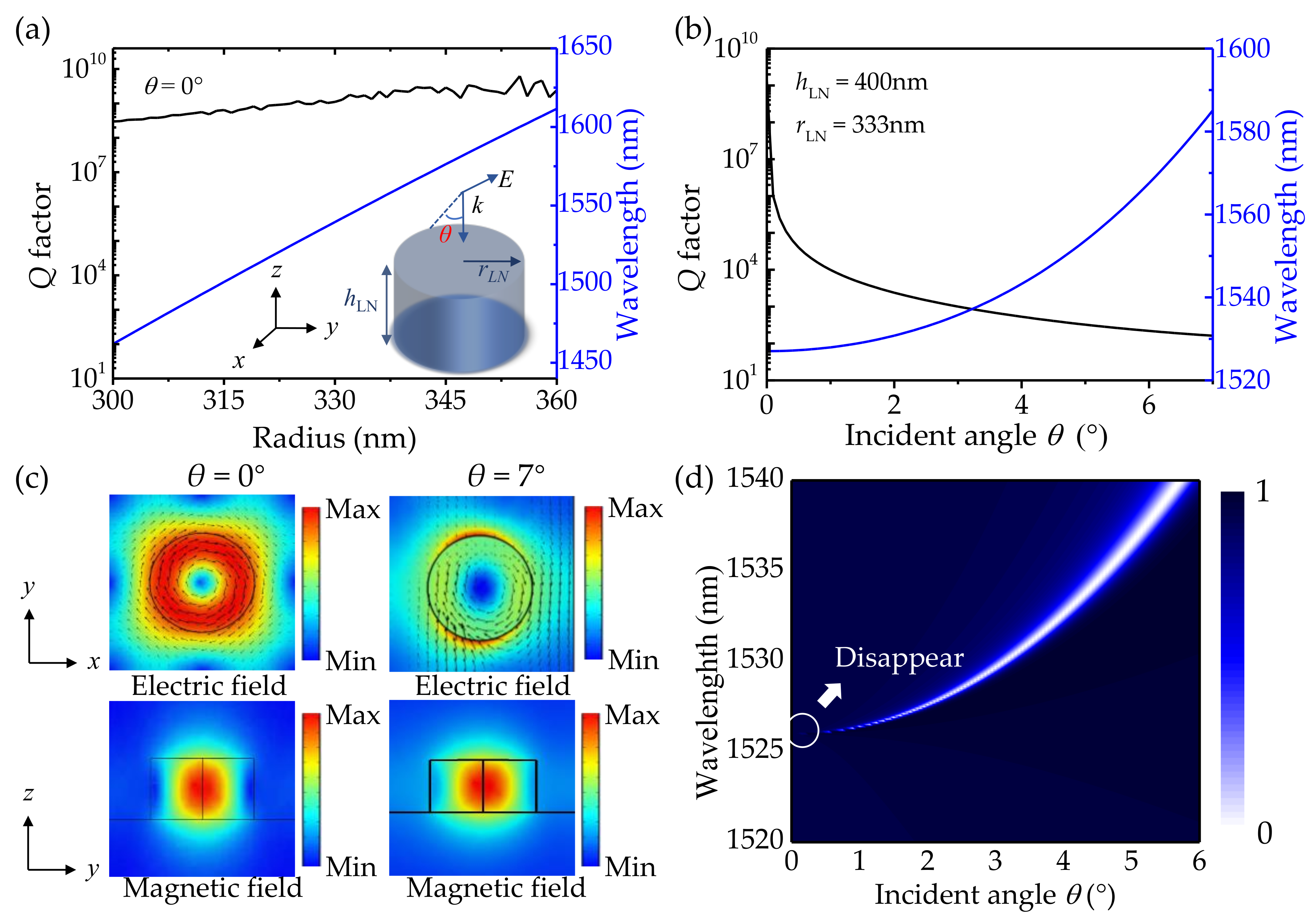

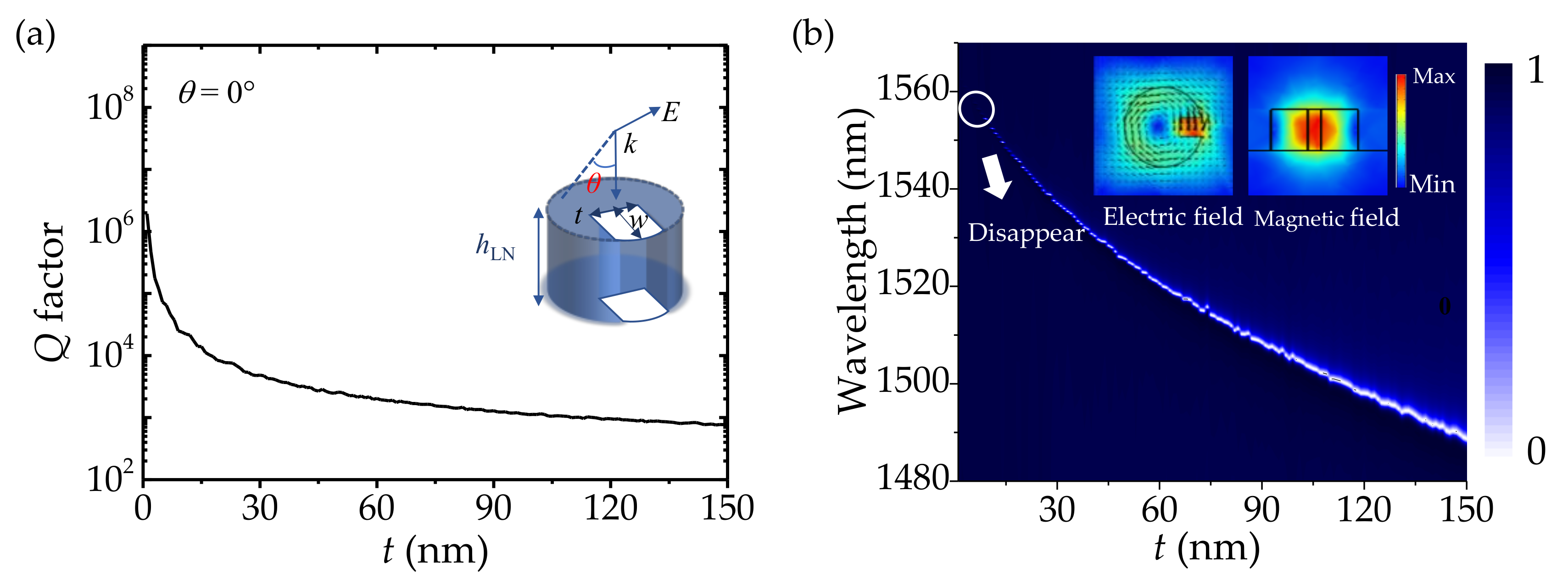
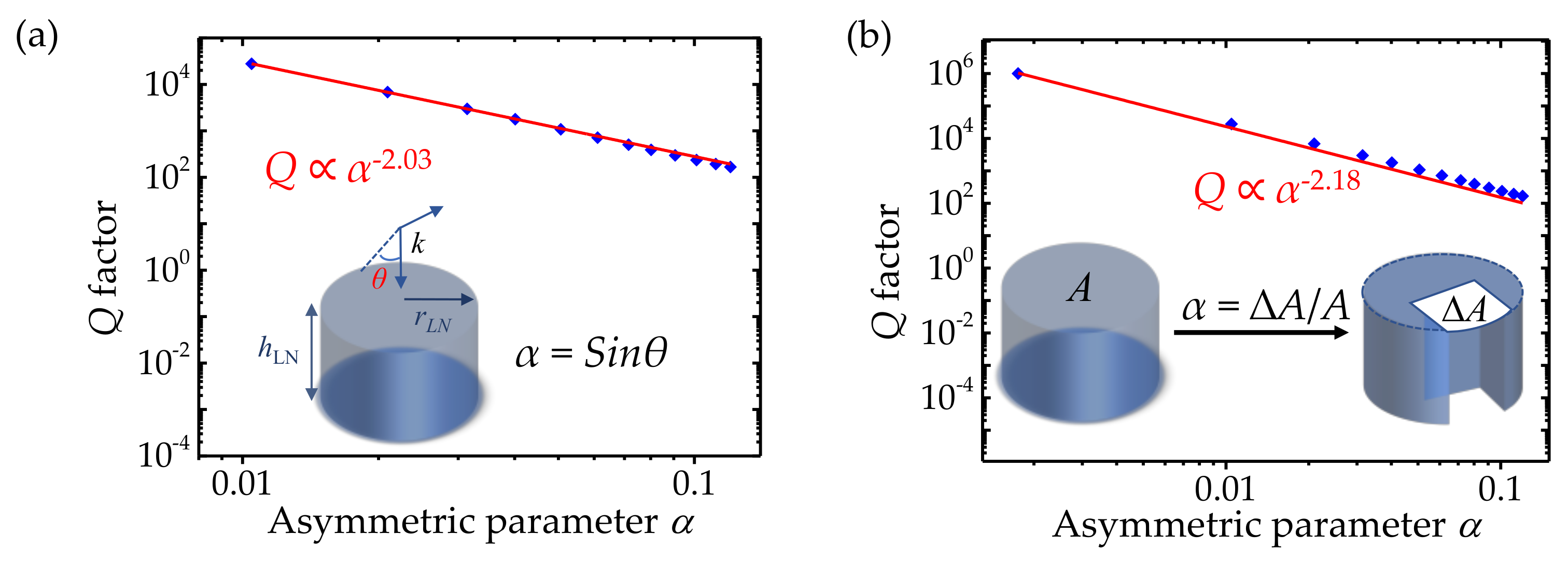


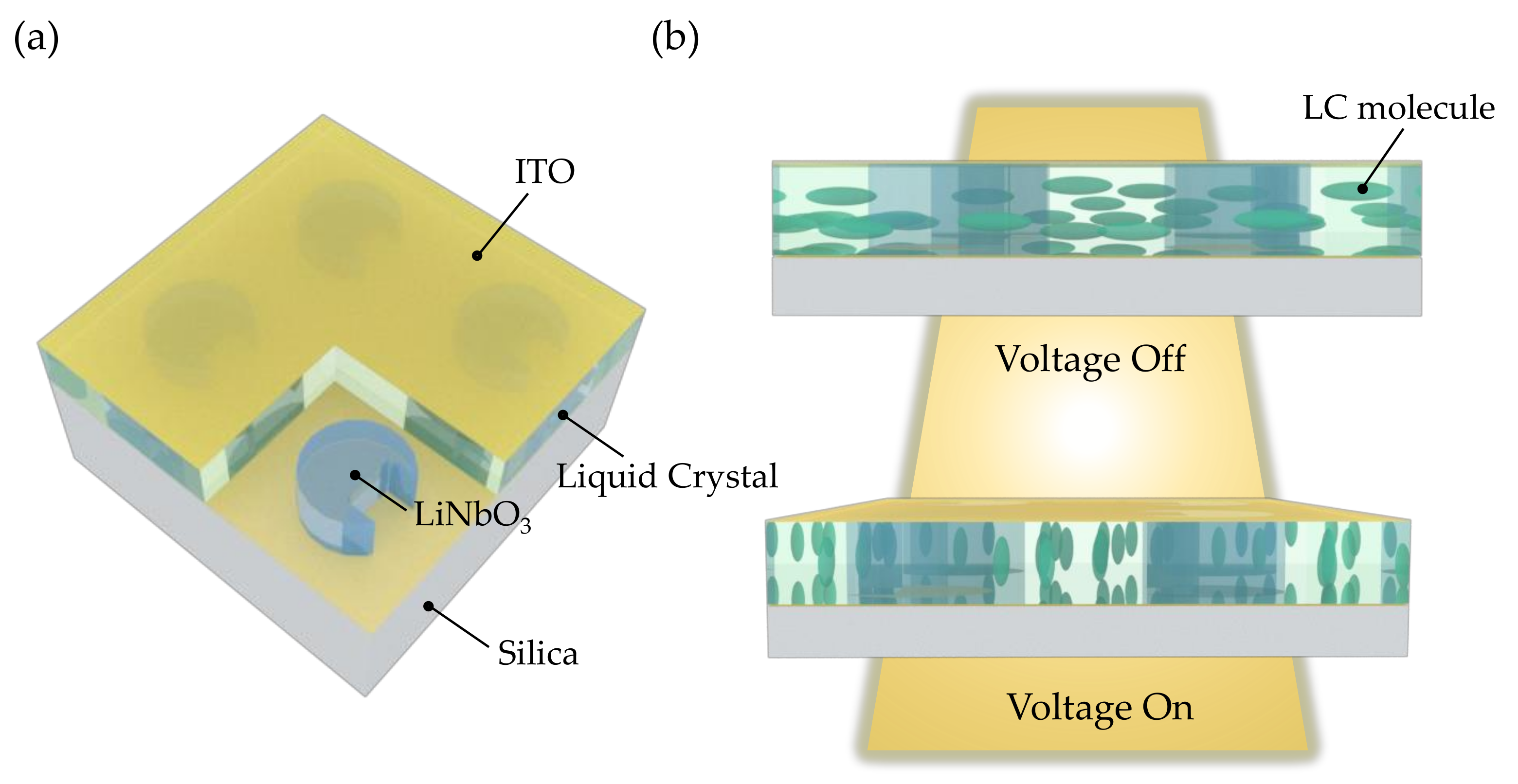
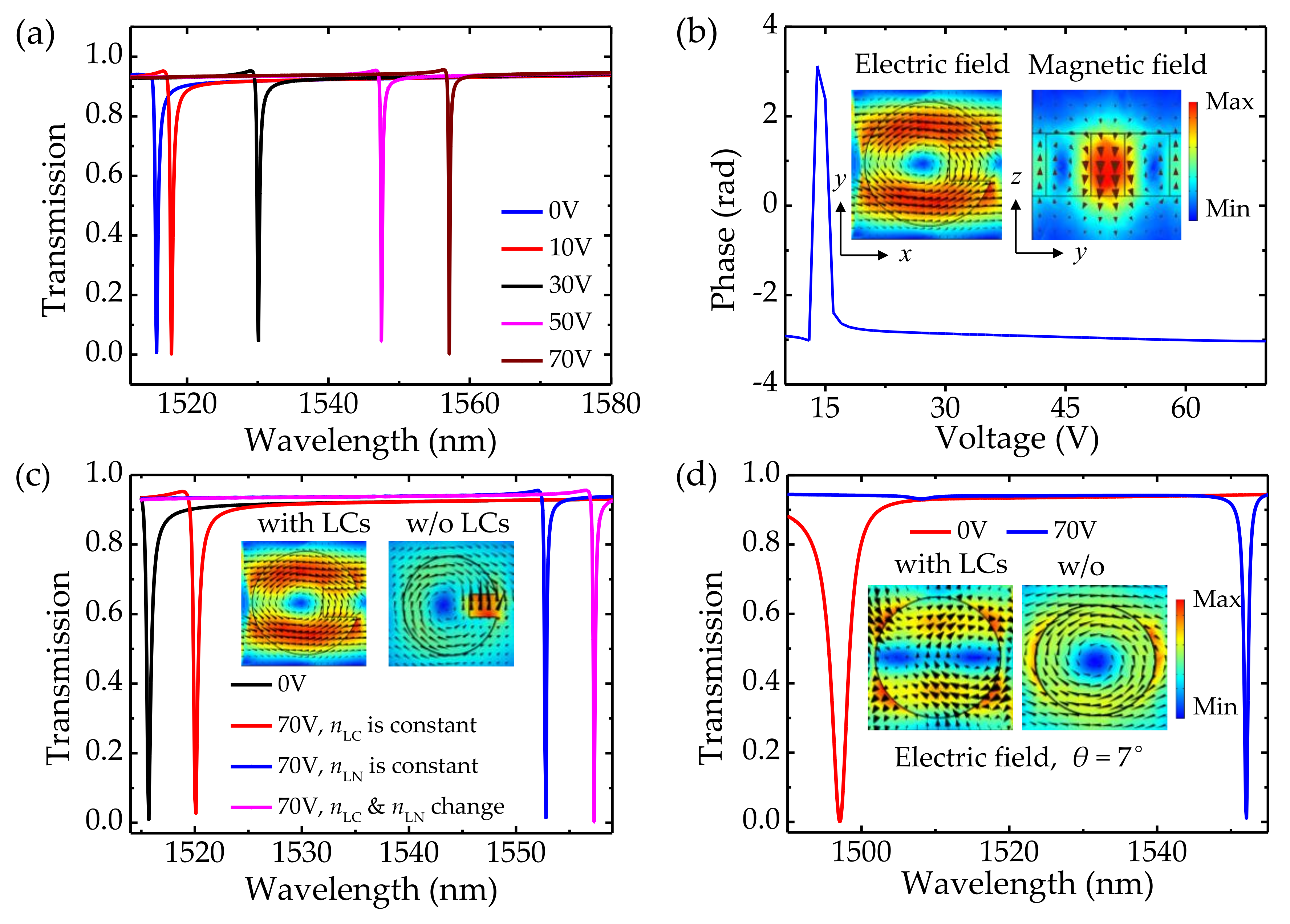
| Year | Ref. | Material | Tuning Sensitivity | Thickness (w/o Substrate) |
|---|---|---|---|---|
| 2017 | [27] | Silicon/LCs | 0.43 nm/V | 5 μm |
| 2018 | [49] | Au/LCs | 381 nm/V | 5 μm |
| 2020 | [50] | BaTiO3 | 0.04 nm/V | 0.2 μm |
| 2021 | [51] | JRD1:PMMA | 0.031 nm/V | 0.69 μm |
| 2022 | [52] | Si/LNO | 0.01 nm/V | 0.42 μm |
| 2022 | [42] | Al/LiNbO3 | 0.07 nm/V | 0.82 μm |
| 2022 | This work | LiNbO3/LCs | 0.6 nm/V | 0.4 μm |
Publisher’s Note: MDPI stays neutral with regard to jurisdictional claims in published maps and institutional affiliations. |
© 2022 by the authors. Licensee MDPI, Basel, Switzerland. This article is an open access article distributed under the terms and conditions of the Creative Commons Attribution (CC BY) license (https://creativecommons.org/licenses/by/4.0/).
Share and Cite
Kanyang, R.; Fang, C.; Yang, Q.; Shao, Y.; Han, G.; Liu, Y.; Hao, Y. Electro-Optical Modulation in High Q Metasurface Enhanced with Liquid Crystal Integration. Nanomaterials 2022, 12, 3179. https://doi.org/10.3390/nano12183179
Kanyang R, Fang C, Yang Q, Shao Y, Han G, Liu Y, Hao Y. Electro-Optical Modulation in High Q Metasurface Enhanced with Liquid Crystal Integration. Nanomaterials. 2022; 12(18):3179. https://doi.org/10.3390/nano12183179
Chicago/Turabian StyleKanyang, Ruoying, Cizhe Fang, Qiyu Yang, Yao Shao, Genquan Han, Yan Liu, and Yue Hao. 2022. "Electro-Optical Modulation in High Q Metasurface Enhanced with Liquid Crystal Integration" Nanomaterials 12, no. 18: 3179. https://doi.org/10.3390/nano12183179
APA StyleKanyang, R., Fang, C., Yang, Q., Shao, Y., Han, G., Liu, Y., & Hao, Y. (2022). Electro-Optical Modulation in High Q Metasurface Enhanced with Liquid Crystal Integration. Nanomaterials, 12(18), 3179. https://doi.org/10.3390/nano12183179





